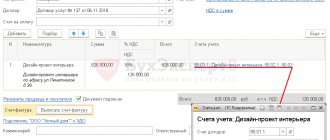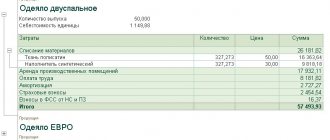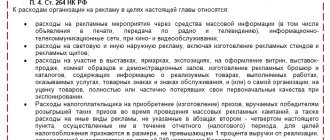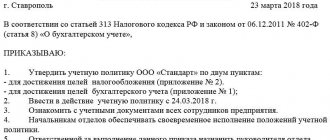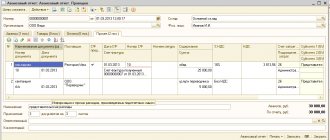Kontur.Accounting is a web service for small businesses!
Quick establishment of primary accounts, automatic tax calculation, online reporting, electronic document management, free updates and technical support.
Try it
The division of direct and indirect costs is carried out to calculate the tax base and form the cost. This division is important for accounting and tax accounting. In organizations in different industries, expenses of the same type may be classified differently. In order to correctly distribute costs, you need to give them the correct definition.
Direct costs
Direct costs form the cost of only one type of product. In your accounting policy, you must independently determine the costs classified as direct.
Examples of direct costs:
- inventories, components and semi-finished products;
- wages of primary production workers and social benefits;
- depreciation of main production equipment.
The list of direct costs is presented in Art. 318 of the Tax Code of the Russian Federation, it is open and may include other expenses at your discretion. However, before including costs in the list of direct costs, please note: they must be directly related to the production and sale of goods, works and services.
For trade organizations there is a separate list of direct expenses, which is strictly regulated and cannot be changed. These include the cost of goods purchased and transportation costs.
Letter of the law
Answering the taxpayer’s question, financiers, as usual, first cited a number of provisions of tax legislation. In particular, they confirmed that the taxpayer independently determines the list of direct costs associated with the production of goods (performance of work, provision of services) in the accounting policy for tax purposes. And if it is impossible to attribute direct costs to a specific production process for the manufacture of a given type of product (work, service), the taxpayer must also independently determine and prescribe in the accounting policy a mechanism for distributing these costs using economically feasible indicators. According to paragraph 1 of Art. 318 of the Tax Code of the Russian Federation, direct costs can include, in particular : - material costs determined in accordance with paragraphs. 1 and 4 paragraphs 1 art. 254 Tax Code of the Russian Federation; - expenses for remuneration of personnel involved in the production of goods, performance of work, provision of services, as well as expenses for compulsory pension insurance, used to finance the insurance and funded parts of the labor pension, for compulsory social insurance in case of temporary disability and in connection with maternity , compulsory medical insurance, compulsory social insurance against industrial accidents and occupational diseases, accrued on the specified amounts of wages; — the amount of accrued depreciation on fixed assets used in the production of goods, works, and services. And indirect expenses include all other amounts of expenses, with the exception of non-operating expenses determined in accordance with Art. 265 of the Tax Code of the Russian Federation, carried out by the taxpayer during the reporting (tax) period. Indirect expenses are fully included in the expenses of the current reporting (tax) period, but, of course, taking into account the requirements provided for by the Tax Code of the Russian Federation.
Indirect costs
Using the cloud service Kontur.Accounting will help you correctly divide expenses into direct and indirect, as well as reflect them in a timely manner and in full. Get free access to the service for 14 days
Indirect costs form the cost of several types of products simultaneously. There is no way to directly determine which products they should be attributed to. These expenses support production processes and the operation of the organization as a whole. Examples of indirect costs:
- communal payments;
- salaries of support staff, administrative workers and managers;
- depreciation of auxiliary equipment;
- marketing campaigns for company advertising.
The Tax Code states that all costs that you did not classify as direct in your accounting policies are classified as indirect. Non-operating expenses should not be classified as indirect expenses, since they do not have a direct connection with the production and sale of goods, works and services. Distribute indirect costs proportionally across all types of products. Select a base for distribution. The base can be variable costs, for example, wages or the cost of materials.
Indirect costs
What do indirect costs include:
- Use of fixed assets of own capital.
- Costs for remuneration of employees of the organization. At the same time, the costs of paying employees involved in the production process are not taken into account.
- Payment for insurance of the organization, health and property.
- Sales and production costs. Payment of rent, product certification, advertising, clothing for employees, fuel, materials, packaging of goods - all of this refers to indirect costs.
Do you need to select material for your study work? Ask a question to the teacher and get an answer in 15 minutes! Ask a Question
Note 1
At the same time, indirect costs do not include costs for the purchase of goods if they were sold in a given reporting period, as well as transportation costs for the delivery of goods from the warehouse if this is not included in the cost of purchasing goods.
If the organization does not take into account the costs of delivering goods to the warehouse as expenses for the purchase of goods, that is, does not include them in the cost of goods, these costs must be divided between sold and unsold goods. The cost of delivery services to the client's warehouse is always taken into account as an indirect expense of the current month.
Combinations of different cost types
Using the cloud service Kontur.Accounting will help you correctly divide expenses into direct and indirect, as well as reflect them in a timely manner and in full. Get free access to the service for 14 days
Cost classification is based on different criteria, so combinations of them are possible. There are variable and fixed direct and indirect costs.
Direct costs are closely related to production, so most of them are variable. But there are exceptions: for example, the salary of a supervisor who controls the production process of a certain type of product. His salary does not depend on production volumes, which indicates the constant nature of the costs, and the relationship to a specific type of product makes them direct.
Indirect costs are also divided into fixed and variable costs. Fixed expenses include office rent, and variable expenses include the cost of tools, auxiliary materials, etc.
Analysis of direct and indirect production costs
To analyze direct and indirect costs of production (work, services), ordinary standard accounting reports are suitable. It is only important to remember the following.
The division into direct and indirect expenses is carried out by the regulatory document “Closing accounts (20, 23, 25, 26)”. Therefore, information about expenses in tax accounting in standard accounting reports can only be obtained after posting this document. We will focus on specialized reports.
Report “Register of accounting for production costs”.
This report can be opened using the command “REPORTS\Tax accounting registers for income tax\ Production expenses accounting register ”. Depending on the value of the “Type of expenses” attribute, it generates a list of direct or indirect expenses.
Let us immediately note that the list of direct expenses in this report is only potential direct expenses for now. Some of them will become so only after implementation. Remember “direct expenses relate to the expenses of the current reporting (tax) period as products (works, services) are sold ...”, Art. 318 Tax Code of the Russian Federation.
Indirect expenses in tax accounting are recognized as they arise. That is, there is no need to wait for the products to be sold. Their list can be seen if you indicate “Indirect expenses” in the “Type of expenses” detail.
The report “Register of accounting for production costs” can be generated both before and after the regulatory document “Closing accounts (20, 23, 25. 26”).
Report “Analysis of the state of tax accounting for income tax.”
After completing the document “Closing accounts (20, 23, 25. 26,” the data from the report “REPORTS \ Analysis of the state of tax accounting for income tax " becomes relevant. It allows you to analyze direct and indirect taxes that went to reduce the tax base for income tax .
The report can be generated only if there were income, or more precisely sales, for the specified period.
Click on the "Expenses" section. A form will open in which you can see the amounts of direct and indirect expenses recognized in tax accounting.
Let's analyze it. And so, the report shows that the program recognized direct expenses in the amount of 30,720 rubles. However, we saw above that direct expenses should be twice as much - 61,440 rubles. The reason is that we used exactly two chairs worth of materials for production. They also released two chairs. But they sold one chair. And direct costs, as we remember, are accepted as products are sold.
You can further drill down into the report data by clicking on the appropriate accounting sections. But we'll move on to other reports.
Help-calculation “Product cost”.
This report can be opened using the command “REPORTS\References-calculations\ Cost of products ”. It allows you to display the actual cost of production, both in accounting and tax accounting.
The printed form of the report is an accounting document. It approves the distribution of production costs into the cost of manufactured products and the cost of services provided in the month the report is generated.
Help-calculation "Calculation".
This report can be opened using the command “REPORTS\Calculation references\ Calculation ”. It allows you to display the composition of expenses that formed the actual cost of production, both in accounting and tax accounting.
The printed form of the report is an accounting document. It approves the composition, quantitative and monetary characteristics of the costs for the production of manufactured products and the provision of production services in the month the report is generated.
Direct and indirect costs in accounting
Of all the costs of manufacturing a product, its cost is added up. Account 20 contains almost all production costs that can be classified as direct. The main production account on debit corresponds with accounts 02, 10, 23, 25, 26, 60, 69, 70 on credit. To determine the cost of a product of a certain type, open analytical accounts for individual types of products and costs for account 20. This will simplify the procedure for generating cost by type.
Indirect costs are contained in accounts 25 and 26. To prepare loan entries, the same correspondence is used as for direct costs. Do not forget that indirect costs cannot be attributed directly to the cost of one product. Select a reasonable allocation basis and note your choice in the accounting policy.
Direct and indirect production costs
Articles 271-273 of Chapter 25 of the Tax Code of the Russian Federation provide for income tax payers two alternative ways of determining income and expenses. The desired method must be fixed in the accounting policies of the organization.
- Accrual method . It is universal and suitable for all occasions.
- Cash method . Sometimes it is more convenient, but it has a number of limitations.
Payers of income tax are organizations that apply the general taxation system (OSNO). For these organizations, the 1C Accounting 8 program uses only the accrual method.
According to paragraph 1 of Art. 318 of the Tax Code of the Russian Federation, income tax payers who use the accrual method are required to maintain costs for the production and sale of goods (works, services), dividing them into direct and indirect costs. This is explained by different conditions for their recognition in tax accounting, see clause 2 of Art. 318 Tax Code of the Russian Federation.
- Indirect costs . Indirect costs of production and sales incurred in the current reporting (tax) period are fully recognized as expenses in the same tax period. That is, even if there was no sale in the current period, indirect expenses still reduce the taxable profit of this period.
- Direct expenses . Direct expenses refer to expenses of the current reporting (tax) period as products (works, services) are sold, in the cost of which they are taken into account in accordance with Article 319 of this Code. That is, taking into account the balance of work in progress.
An exception may be cases when an organization provides production services. Such taxpayers have the right to attribute the amount of direct expenses incurred in the reporting (tax) period in full to the reduction of income from production and sales of this reporting (tax) period without distribution to the balances of work in progress.
Subscribers to the ITS can find details of the recognition of direct and indirect expenses in the article “Production-related expenses” on the website of the Internet version of the ITS.
The list of direct expenses is not regulated by law. This means that the organization independently determines in its accounting policy the list of direct expenses, but taking into account the provisions of paragraph 1 of Art. 318 Tax Code of the Russian Federation.
- Material costs . Determined in accordance with paragraphs 1 and paragraph 4 of paragraph 1 of Art. 254.
- Labor costs . Expenses for remuneration of personnel involved in the production of goods, performance of work, provision of services, as well as expenses for compulsory pension insurance, used to finance the insurance and funded part of the labor pension for compulsory social insurance in case of temporary disability and in connection with maternity, compulsory medical insurance, compulsory social insurance against industrial accidents and occupational diseases, accrued on the specified amounts of labor costs.
- Depreciation . Amounts of accrued depreciation on fixed assets used in the production of goods, works, and services.
To separate direct and indirect costs in tax accounting in the 1C: Accounting 8 configuration, the information register “Methods for determining direct and indirect production costs in tax accounting” is intended.
But before studying it, open “ENTERPRISE\Chart of Accounts\ Chart of Accounts ” and pay attention to the following points. Those accounts on which tax accounting is maintained are marked with the sign of tax accounting - the presence of a flag in the “NU” column. The cost accounts (20, 23, 25, 26) also have a tax accounting feature. In addition, these accounts have a subaccount “Cost Items”.
In turn, cost items are described in the directory of the same name “Cost Items”. Among the details of this directory there is the attribute “Type of expense”. Its value is used for tax accounting purposes.
If the entire list of cost items could be divided into two non-overlapping lists (direct and indirect cost items), then it would be enough to simply create two corresponding directories and solve the problem of dividing costs into direct and indirect.
However, the difficulty is that the same cost item in some situations may relate to direct costs, in others to indirect costs. For example, a cost item with the expense type “Payroll”. This is a direct expense for remuneration of production personnel. But remuneration of management personnel is an indirect expense.
Direct and indirect expenses in tax accounting
Using the cloud service Kontur.Accounting will help you correctly divide expenses into direct and indirect, as well as reflect them in a timely manner and in full. Get free access to the service for 14 days
In tax accounting, expenses are also divided into direct and indirect, but for different purposes. The task of accounting is to formulate the cost per unit of production, and for tax accounting it is important at what point the costs are charged to the cost of production. The size of the tax base will vary depending on the amount of direct and indirect costs.
Direct expenses are charged to the current tax period only after the products to which they are charged have been sold.
Indirect expenses are in no way related to sales; they reduce the tax base in the same reporting period in which they arise.
If in your organization the volume of indirect costs exceeds direct ones, then the costs will be taken into account earlier and the amount of taxable profit will decrease. You need to carefully monitor the rationale behind your decisions to classify expenses as indirect. If you underestimate the amount of direct expenses or incorrectly account for them, the tax authorities may consider this a violation and hold you accountable.
Lack of income from activities
If an organization that is obliged to distribute costs in tax accounting into direct and indirect did not have income from sales during the reporting period, then, in the opinion of the Ministry of Finance, it can only declare indirect costs incurred. Direct expenses are recognized only as products/goods/work are sold.
Fiscal structures take a more categorical position regarding the recognition of expenses in the absence of revenue. From the point of view of the Federal Tax Service, if the company does not conduct activities aimed at making a profit, then it is impossible to take into account the expenses incurred when calculating income tax. This prohibition applies to both direct and indirect expenses.
Direct expenses in accounting in 1C 8.3
Direct expenses in accounting for 1C 8.3 will be those expenses that, when producing or providing services or carrying out work, will be taken into account as a debit to account 20 (23).
To reflect on the debit side of account 20 direct expenses for accounting in 1C 8.3, you need to set the parameters in the Accounting Policy, on the Costs tab:
It is necessary to indicate with a checkbox the types of activities for which the costs are planned to be taken into account on account 20. The checkbox is checked if direct production costs are taken into account for the production of products and the checkbox is checked for carrying out work and providing services to customers. The checkboxes are checked in order to keep or not keep records of direct expenses in the debit of account 20.
If this expense is direct according to the accounting policy of the organization, then in the transactions in 1C 8.3 you need to reflect the expense on the debit of account 20.
Direct expenses in tax accounting in 1C 8.3
Direct expenses in tax accounting are those expenses, the list of which is reflected in the Accounting Policy. In this case, the list of direct expenses must be specified in the Tax Accounting Policy. This is very important, because this list can be created independently, the Tax Code speaks about this.
To indicate the list of direct expenses in the 1C 8.3 database, there is a setting in the Accounting Policy, which is located in the menu - Accounting Policy item - Income Tax tab - hyperlink Methods for determining direct production costs in NU:
In 1C 8.3, the hyperlink “Methods for determining direct production costs in NU” determines the composition of direct costs for income tax:
What to do if an accountant finds it difficult to independently determine which direct expenses are in his organization was studied in detail at the Master Class “The whole truth about Income and Expenses”.
In tax accounting, there is no direct dependence on which account in the tax chart of accounts the posting is indicated on.
- The fact that the accounting system will be reflected in the debit of account 20, type of expense - Material expenses, will be a direct expense for the accounting system.
- If it is reflected in the debit of account 25, type of expense - Material expenses, this will also be a direct expense for NU.
The principle that if the count is 20, then this is only a direct expense for NU does not apply. The method that is added to “Methods for determining direct costs” is the method that will operate in 1C 8.3:
If for tax accounting expenses are taken into account in the debit of account 26, then in 1C 8.3 it is necessary to make a distribution of indirect expenses for account 26 “In the cost of products, works, services”:
Thus, account 26 is not written off at a time, but is distributed into account 20. This is convenient for those organizations that have decided to bring accounting and tax accounting closer together. When accounts 25 and 26 are distributed to the debit of account 20, that is, the full cost is calculated, it turns out that if account 26 is not defined as part of direct expenses, then the difference will be between accounting and tax accounting. This is normal, and this is what is expected by law.
Account 44 cannot be specified in “Methods for determining direct expenses”. Even if you add 44 accounts, the 1C 8.3 program will not define it as a direct expense. Also, if account 26 is added to the “Methods for determining direct expenses”, but in the Accounting Policy parameters the distribution of indirect expenses using the direct costing method is set, then account 26 will not be defined as a direct expense. Only if accounts 25 and 26 are distributed to the debit of account 20 and a list of direct expenses is specified, then everything will work in 1C 8.3.
